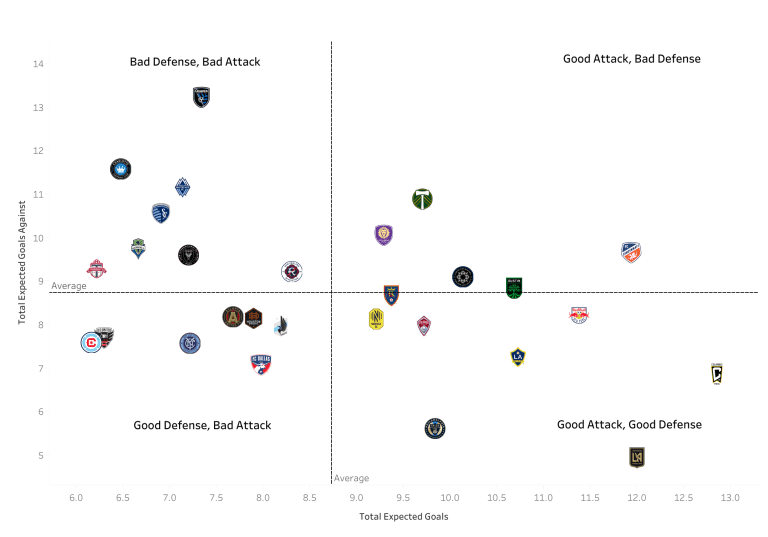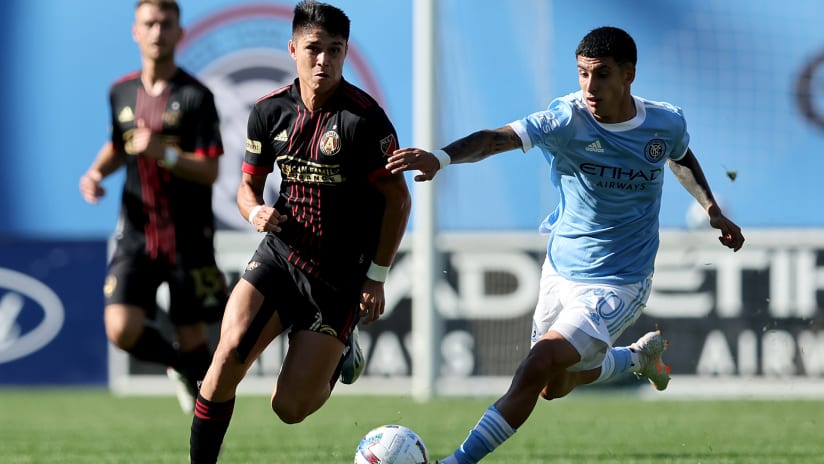A shade under 20 percent of the 2022 campaign is complete for most Major League Soccer clubs, meaning a critical mass of data is starting to accumulate to evaluate which teams are performing above, at, or below expectations.
That especially manifests when sifting through the early-season expected goals figures, both of the scored and conceded varieties.
Let’s take a closer look at the Opta data to learn who’s starting to separate from the pack with sterling play or is hamstrung by some worrisome trends.
Expected goals scored (xG)
The Columbus Crew currently head the league's top five xG generators, with 12.86 through six games, which is 2.86 above the total number of goals they've actually scored (10). Midfield playmaker Lucas Zelarayan's 4g/2a are playing a key role here.
FC Cincinnati are probably the biggest surprise presence in the top five, coming in at third with 11.94 xG, giving some reinforcement to the strides Brandon Vazquez and Luciano Acosta have spearheaded early into their first season under new head coach Pat Noonan.
Team |
xG |
Goals Scored |
xG-G |
|---|---|---|---|
Columbus Crew |
12.86 |
10 |
2.86 |
LAFC |
12 |
14 |
-2 |
FC Cincinnati |
11.94 |
8 |
3.94 |
New York Red Bulls |
11.38 |
10 |
1.38 |
LA Galaxy |
10.73 |
9 |
1.73 |
Chicago Fire FC have been much improved defensively in the early going, but their attack remains a work in progress, as demonstrated by their xG total of 6.16, which is the league's lowest through six weeks. Xherdan Shaqiri is still finding his stride, and winger Jairo Torres arrives May 1 from Liga MX's Atlas.
Somewhat surprisingly, Seattle Sounders FC find themselves in the bottom five at just 6.66 xG in six games, though that's likely colored by juggling Concacaf Champions League obligations. Plus, DPs Nicolas Lodeiro and Raul Ruidiaz were dealing with injuries.
Team |
xG |
Goals Scored |
xG-G |
|---|---|---|---|
Chicago Fire FC |
6.16 |
5 |
1.16 |
Toronto FC |
6.22 |
9 |
-2.78 |
D.C. United |
6.3 |
5 |
1.3 |
Charlotte FC |
6.48 |
7 |
-0.52 |
Seattle Sounders FC |
6.66 |
6 |
0.66 |
Expected goals allowed (xGA)
The San Jose Earthquakes have been the league's leakiest defense with 15 goals conceded, tied with CF Montréal and Inter Miami CF for the highest total in MLS through six weeks. In concert, their xGA (13.21) is also the highest mark league-wide.
Two traditionally strong defensive teams, Sporting Kansas City and the Portland Timbers, also find themselves in the top five of xGA.
Expansion side Charlotte FC have conceded the fewest actual goals of any team in this group (9), but have the second-highest xGA (11.57), a testament to goalkeeper Kristijan Kahlina.
Team |
xGA |
Goals Conceded |
xGA-GA |
|---|---|---|---|
San Jose Earthquakes |
13.21 |
15 |
-1.79 |
Charlotte FC |
11.57 |
9 |
2.57 |
Vancouver Whitecaps FC |
11.15 |
12 |
-0.85 |
Portland Timbers |
10.71 |
13 |
-2.29 |
Sporting Kansas City |
10.53 |
11 |
-0.47 |
LAFC have been lockdown defensively while starting strong under first-year head coach Steve Cherundolo, yielding opponents just 4.93 xGA through six weeks, which is 1.07 from the six goals they've actually conceded.
The Philadelphia Union have remarkably conceded just two goals in their first six games, though their xGA (5.6) suggests that number is a bit fortunate and is perhaps a testament to goalkeeper Andre Blake's strong play.
The LA Galaxy, home to well-documented defensive struggles in recent years, have been much more sound to start Year Two under Greg Vanney, with just six goals conceded and 7.24 xGA.
Team |
xGA |
Goals Conceded |
xGA-GA |
|---|---|---|---|
LAFC |
4.93 |
6 |
-1.07 |
Philadelphia Union |
5.6 |
2 |
3.6 |
Columbus Crew |
6.85 |
7 |
-0.15 |
FC Dallas |
7.06 |
4 |
3.06 |
LA Galaxy |
7.24 |
6 |
1.24 |
League-wide picture
The below graph, as divided into four quadrants, shows how all 28 MLS clubs are performing when comparing xG and xGA.
The bottom right is a reflection of a strong attack + defense (i.e. LAFC), while the top left displays teams with a struggling attack + defense (i.e. San Jose) – at least measured via Opta's data.
Of course, real-world results can often contradict what the underlying numbers say. But it still provides a useful framework for how teams are evolving early on.













